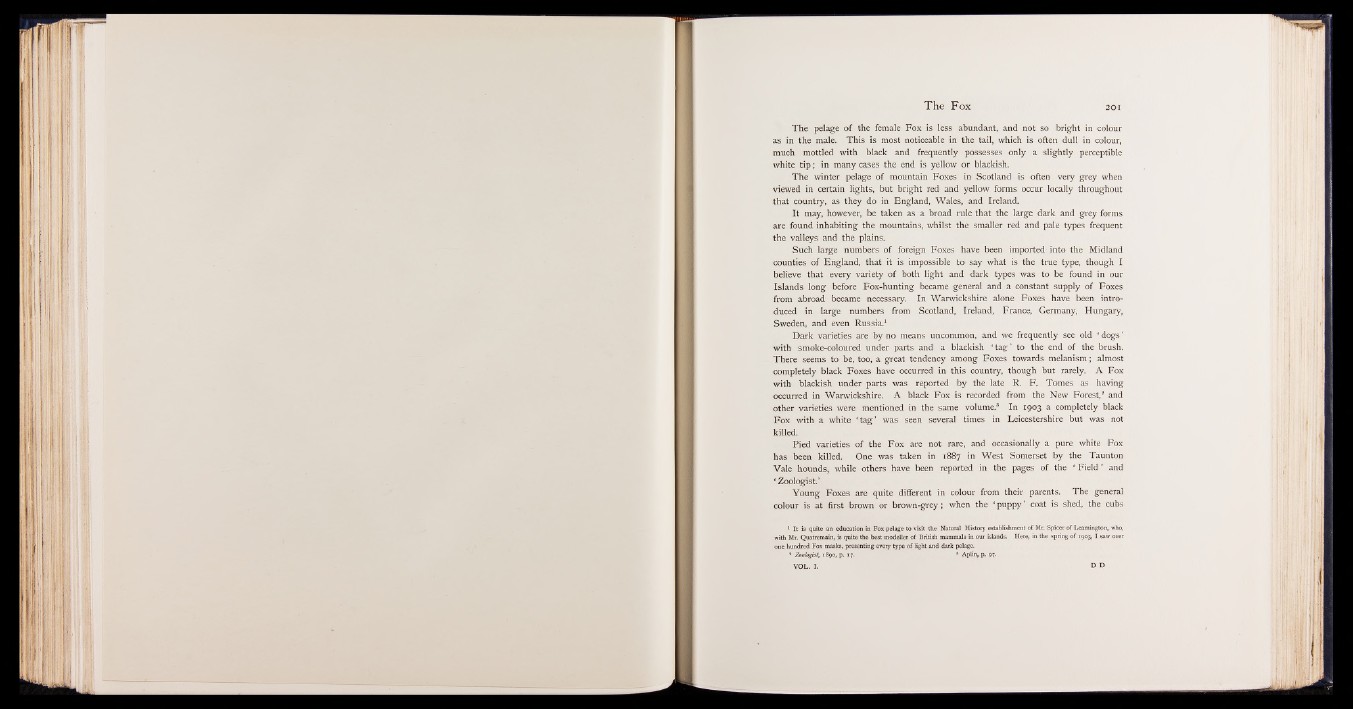
The pelage of the female Fox is less abundant, and not so bright in colour
as in the male. This is most noticeable in the tail, which is often dull in colour,
much mottled with black and frequently possesses only a slightly perceptible
white tip ; in many cases the end is yellow or blackish.
The winter pelage of mountain Foxes in Scotland is often very grey when
viewed in certain lights, but bright red and yellow forms occur locally throughout
that country, as they do in England, Wales, and Ireland.
It may, however, be taken as a broad rule that the large dark and grey forms
are found inhabiting the mountains, whilst the smaller red and pale types frequent
the valleys and the plains.
Such large numbers of foreign Foxes have been imported into the Midland
counties of England, that it is impossible to say what is the true type, though I
believe that every variety of both light and dark types was to be found in our
Islands long before Fox-hunting became general and a constant supply of Foxes
from abroad became necessary. In Warwickshire alone Foxes have been introduced
in large numbers from Scotland, Ireland, France, Germany, Hungary,
Sweden, and even Russia.1
Dark varieties are by no means uncommon, and we frequently see old ‘ dogs’
with smoke-coloured under parts and a blackish ‘ ta g ’ to the end of the brush.
There seems to be, too, a great tendency among Foxes towards melanism; almost
completely black Foxes have occurred in this country, though but rarely. A Fox
with blackish under parts was reported by the late R. F. Tomes as having
occurred in Warwickshire. A black Fox is recorded from the New Forest,2 and
other varieties were mentioned in the same volume.8 In 1903 a completely black
Fox with a white ‘ tag’ was seen several times in Leicestershire but was not
killed.
Pied varieties of the Fox are not rare, and occasionally a pure white Fox
has been killed. One was taken in 1887 in West Somerset by the Taunton
Vale hounds, while others have been reported in the pages of the ‘ Field’ and
‘ Zoologist.’
Young Foxes are quite different in colour from their parents. The general
colour is at first brown or brown-grey; when the ‘ puppy’ coat is shed, the cubs
1 It is quite an education in Fox pelage to visit the Natural History establishment of Mr. Spicer of Leamington, who,
with Mr. Quatremain, is quite the best modeller of British mammals in our islands. Here, in the spring o f 1903, 1 saw over
one hundred Fox masks, presenting every type of light and dark pelage.
* Zoologist, 1890, p. 17. 3 Aplin, p, 97.
VOL. I. D D